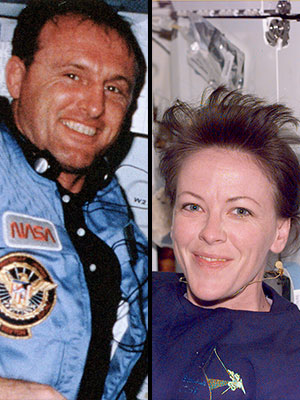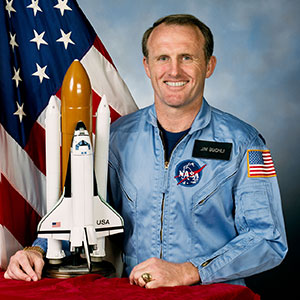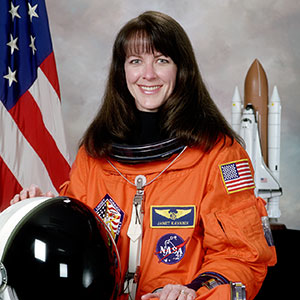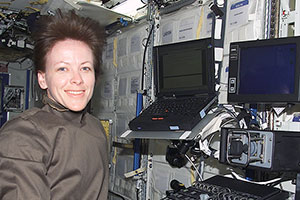December 21, 2018 — A member of NASA's "Thirty-Five New Guys" and the 35th woman to fly into space will enter the U.S. Astronaut Hall of Fame in April.
James Buchli, who joined the "TFNG," NASA's first class of shuttle astronauts, in 1978, and Janet Kavandi, who today leads a NASA research center in Ohio, will be enshrined in the Astronaut Hall of Fame as its 2019 inductees at the Kennedy Space Center Visitor Complex in Florida. A public ceremony on Saturday, April 6, 2019, followed by a gala dinner hosted by the Astronaut Scholarship Foundation, will welcome Buchli and Kavandi into the Hall's ranks.
"It is quite an honor to be inducted into something like this, amongst your peers," said Buchli in an interview with collectSPACE. "It has given me a chance to reflect back on my NASA career and think about all of the people who were involved in making our space program what it is today."
"It is quite an honor," said Kavandi, "because I know there is a small percentage of astronauts who fly in space who are asked to join this exclusive group of people."
Both Buchli and Kavandi served as space shuttle missions specialists. Buchli flew on four missions between between 1985 and 1991, logging more than 20 days in orbit. Kavandi flew on three missions between 1998 and 2001, spending 34 days off the planet.
From classified to climate research
Buchli, who is now 73 and retired, was 32 years old and serving in the U.S. Marine Corps when he was announced as an astronaut candidate in NASA's eighth group of spaceflight trainees.
"It was a progression of where I was in aviation and an opportunity that my wife and I decided we ought to try. And we did. And, you know, it worked out," he said.
After serving as a support crew member for the two space shuttle missions in 1981 and helping develop the protocols for conducting shuttle-based spacewalks, Buchli received his first flight assignment. In January 1985, he launched on the orbiter Discovery as member of the STS-51C crew.
"I used to say that it was like being strapped to the front of a freight train going down the track at 90 miles an hour. But it was not even close. It was much, much more energy than that," he said.
Beyond that, though, Buchli is limited in what he can say about his first spaceflight.
"So we launched," he said. "We did our mission, most of which, believe it or not, is still classified. And we were successful."
STS-51C was NASA's first mission devoted to a Department of Defense payload.
"It was a real pathfinder in how an open, government entity like NASA can work hand in glove with the Department of Defense and with items and processes that need to be classified," Buchli said.
His subsequent three shuttle missions were flown in the open, as they focused on scientific research and deploying NASA satellites.
Eleven months after his first flight in November 1985, Buchli lifted off on the final successful mission of the space shuttle Challenger. He and his seven STS-61A crewmates set a still-standing record for the largest crew contingent to launch and land together. The mission, which was dedicated to German science experiments aboard a European Spacelab module in Challenger's payload bay, split the crew into two work shifts.
"We worked Red Team, Blue Team, 24 hours. And while the other folks were back in the Spacelab doing the science that they'd trained for, the vehicle belonged to me," Buchli recalled. "So I got to do all the things that the pilot and the commander would do on the other shift, keeping the shuttle squared away and flying properly."
"It was very, very interesting for me to do that because I got to do some things that normally a mission specialist wouldn't get to do. I really enjoyed that. That, for me, was also a pathfinder," he said.
Buchli's third and fourth flights, STS-29 in March 1989 and STS-48 in September 1991, both launched on Discovery. The missions deployed the fourth Tracking and Data Relay Satellite (TDRS) and the Upper Atmosphere Research Satellite, the latter the first orbital observatory to focus on the photochemistry of Earth's ozone layer.
"I flew four different types of missions, and all were what I would consider to be successful," Buchli told collectSPACE. "My attitude on flying in space was as it had been flying airplanes — try to do the best you can do in being prepared and executing the mission, and while you do that, have fun with the people you are flying with. I used to say enjoy the journey, but in this case, it was enjoying every bit of the flight. And I did. I really feel like I did."
Buchli retired from NASA and the Marines in 1992, but did not leave the space industry. He joined Boeing, and then United Space Alliance and Oceaneering to support missions to the International Space Station and extravehicular activity (EVA, or spacewalk) development.
From station to station
Janet Kavandi joined NASA's ranks two years after Buchli left, but it was it was his astronaut class — as the first to include women — that made her dream possible.
"I grew up in a little Midwestern town in the 60s and I remember watching the first satellites," said Kavandi. "We lived out in the country and we could see the sky very clearly, all the stars and we could see the satellites. We could see those little bright light dots that would be circling Earth and my dad and I would say, 'Oh, that is so cool. What would it be like to be up there and look back at Earth. And I wonder what you could see, I wonder what Earth would look like, I wonder what space would look like. What could be up there high up above the atmosphere?'"
"So it always was in my mind to try to do that some day," Kavandi said. "The first flyers, of course, were all male and they were all test pilots so it was sort of off limits to a little girl back at that time. But as I grew older and times changed, we [NASA] started accepting scientists and engineers. The diversity of the astronauts from there on made it a possibility for people like me to apply. So I did."
A chemist by education, she received her doctorate in analytical chemistry, Kavandi's first launch was in June 1998 as a member of Discovery's STS-91 crew on the final shuttle flight to dock to Russia's now-former space station Mir.
"That was a really nice opportunity to go to Russia, to train there and to see the differences in our cultures," said Kavandi. "Our primary payload was the [prototype for the] Alpha Magnetic Spectrometer, which is up on the International Space Station today and has contributed significantly to our knowledge of the universe."
Kavandi's second mission, STS-99 on space shuttle Endeavour in February 2000, was devoted to the Shuttle Radar Topography Mission.
"It was the highest resolution, to date, that Earth has been mapped," explained Kavandi. "We had two receivers and one transmitter and we were able to map out the terrain between 56 degrees south and 56 degrees north, which is most of the habitable regions on Earth."
Her third and final spaceflight was aboard orbiter Atlantis' STS-104 mission to the International Space Station in July 2001.
"That was an assembly mission where we installed the [Quest] airlock," Kavandi said. "That enabled spacewalks to be conducted."
After her three missions, Kavandi was named deputy chief of the Astronaut Office at Johnson Space Center in Houston and then director of flight crew operations, with oversight of both the astronaut corps and the pilots and aircraft NASA flies out of Ellington Airport in Houston.
In 2016, after serving as deputy, she became director of NASA's Glenn Research Center in Cleveland, Ohio.
"The Glenn Research Center is unique. It's one of ten of NASA's centers, four of which are research centers. So we're one of the four research centers and most of them have to do with aeronautics research, which we certainly do, but we are unique in that we do about 40 percent of aeronautics research and then about 60 percent space," Kavandi told collectSPACE.
99 astronauts on the wall
Buchli and Kavandi, who on April 6 will be the 98th and 99th astronauts to enter the Hall of Fame, were selected by a panel of astronauts, flight controllers, historians and journalists overseen by the Astronaut Scholarship Foundation.
To be eligible for the Hall, nominees need to have orbited Earth at least once with their first spaceflight at least 16 years prior to and last flight at least 5 years prior the election year. They must be U.S. citizens trained by NASA and now be retired from the astronaut corps (NASA employees are eligible if they are no longer under consideration for a flight assignment).
Founded in 1990 on the suggestion of the then-surviving Mercury astronauts, the U.S. Astronaut Hall of Fame is now a featured part of Heroes & Legends, a public attraction at the Kennedy Space Center Visitor Complex. |
|

James Buchli, seen aboard the space shuttle Discovery during the STS-51C mission in 1985, and Janet Kavandi, seen aboard space shuttle Endeavour during the STS-99 mission in 2000, will enter the U.S. Astronaut Hall of Fame as the 2019 inductees on April 6 at the Kennedy Space Center Visitor Complex in Florida. (NASA)

NASA portrait of astronaut James "Jim" Buchli from 1987. (NASA)

NASA astronaut James Buchli seen with MIT's Middeck 0-Gravity Dynamics structural Experiment (MODE) aboard the space shuttle Discovery during the STS-48 mission in 1991. (NASA)

NASA portrait of astronaut Janet Kavandi from 2001. (NASA)

NASA astronaut Janet Kavandi at a robotics work station on board the International Space Station during space shuttle Atlantis' STS-104 mission in 2001. (NASA)

The U.S. Astronaut Hall of Fame, as featured in Heroes & Legends at the Kennedy Space Center Visitor Complex in Florida. (KSCVC) |
